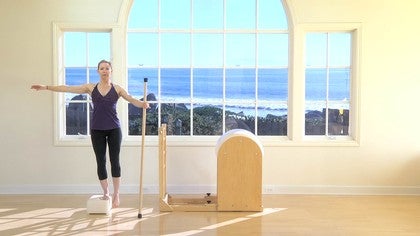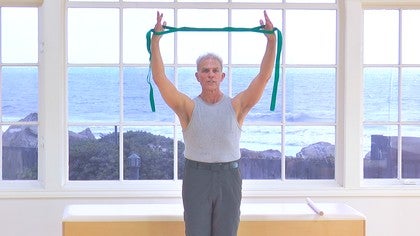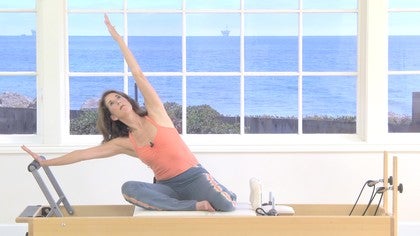Description
About This Video
Transcript
Read Full Transcript
I, I'm Amy, I'm going to be doing class today that's appropriate for maybe somebody has osteoporosis, maybe somebody's a little deconditioned, um, someone that might be dealing with some ankle rehabilitation or knee rehabilitation or just learning about what that stability needs to be like. Um, a lot of attention on hip joint, glute Quadricep, weight transfer, and then moving on to that'll be here with the moon box and then moving to the barrel, some, a scapular or work, some pushup type of work here. Um, and then moving onto the barrel, more scapular work and some back extension. So, uh, no flection in this class. Uh, pretty safe. And for new teachers out there, this is some of the ideas can help you in preparation for larger exercises on different pieces of equipment. So lots to kind of think about. So what we're going to first work on, and I'll just stand parallel and we're just going to work the feet a little bit.
So as you're standing, just that nice sense of plum line, relaxing your rib cage, just easy shoulders. And I just want us to just shift the weight forward to the front of the feet and then back toward the heels. Just to play with your sense of where you are on your legs front to back. And you'll notice there's what I notice anyways. There's a moment. If I go too far forward, I feel like I'm going to lose my balance.
That's very natural and going back pretty natural as well. I don't want anybody to lose their balance. So part of this work and some of the exercises, if you have a senior, for example, and I teach a lot of older clients, they're not competent on their legs, they're not confident, maybe climbing stairs or they're working on fall prevention. So some of this is helping them understand those natural moments are going to happen. But find your body, find yourself to kind of recover from that sense of falling. Okay? And then a little bit side to side and just kind of give your ankles and your feet a little, little something. Nothing too fancy. Okay.
Then let's work our feet. I'm going to start my right foot. I'm going to lift my heel, trying to track my leg parallel and just lower basic stuff that shows up on reformer. But let's think about the foot and as I'm lifting the heel up, I don't want the heel to go out or in if possible, very parallel. And also I'm going to pause here and push the ball of the foot into the floor. We're really gonna push it in before I lower my heel and the other side rather than just to kind of lift the heel up, what's going on, I'm lifting, pushing my foot into the ground, feeling the ground and lowering the heel and to do it again, to feel the floor, try to spread the foot and spread the foot. Okay, so you could stay with that without any kind of a balance support.
So I've got the ladder barrel to hold on to where you also might give your client a bar a stick to hold on to. I'm going to hold it here and go into the first foot lifted again. Now as I go up with both heels, I'm going to focus on this foot pushing into the floor to rise up to both and then lower, not really thinking about the heel lift as much as the foot, the ball of the foot pushing down to go up and changing feet. So that's what happens when we walk through our day. Yes we do. We'll go off of our heel land there first and push off the ball of the foot.
I think we're missing that, especially seniors as they start to shuffle. They're not getting that foot movement then ankle movement. So encourage them to push into the ground. They'll probably, some of them might cramp in their calves. So just be patient with them. Empower them that this is, you know, to help them walk. This is going to help them not shuffle, be better on their balance.
If one arm is too unstable, feel free to put them in the center. All right, so I'm going to go back up now with both feet and as I lower the heels, keeping the weight real light pushed down through the ball of the feet and lift four to five times. Depending on your client. Push down to lift and lower. They can push down into the stick and left. You can have two sticks. I've just got the one of course, push down to lift and lower and there's a note, a noticeable weight transfer that's happening from the heel up to the ball of the foot. One more time. Push and lift. Okay, so in parallel, and let's do the same thing in a very small external rotation from the hip through the knee, ankle, and the foot. So same thing. I'm going to just go my heel lift and lower and left, pushing the ball of the foot to the ground and lower and try to tap into.
When you do push your foot to the ground, what do you feel in your upper leg? You want to feel some work in your inner thigh, around the back of your thigh, up into your buttocks and push. Use the floor. Remember that's going to be what you walk on, what you're walking through. Here we go. So heel, going up with both heels lifting, but push into the ground to rise up and exchange feet and push and lift and lower. Push and lift and lower. And let's go one more. So about four. Now at this moment, you know here's another, then another example, maybe one hand in one hand here.
And I want you to keep your heels touching. So some of us have pretty extended ankles and we can go way up there. We might slightly be out of the muscle tone in the foot and ankle. So bring it down. Heels touching. This is actually a little bit more daily living function. You're not that high.
Let's see. Where's your stilettos? And lower down. So pushing into the ground and lift. Keep the heels together and lower. So again, push and lift and lower. And so what I'm feeling too with the heel connection there is all the way up into my inner thigh. There's tone and the muscle up there. You don't want looseness there. You want the legs connected again.
You're gonna feel it around the seat. Couple more. Push into the floor and lower and notice the weight shift in the weight transfer and then we're coming down. All right, you can do that. Get creative. Some of you teachers out there you can do with one foot forward, you know, play with it a little bit. I'm gonna move on. So I think I'll put my stick just here for now. We'll get back to it. And then I'm going to bring in the hip hinge concept. Some of us, I'll do a lot of this on the site. Um, again, hip joint function, very important. The glide of the femur.
So put yourself in a real small knee bend parallel. And I'm going to put the pinky finger in my hand right there at the joint, the hip joint there, like a little karate chop. I'm going to take the torso and just lightly hinge or lean forward, keeping the chest open and then bring the torso back. So it's very slight. But again, if you've got an unsteady person, uh, a senior again there, you're gonna want to have them hold on. Probably makes them feel like they're gonna fall and you don't want them to fall. You want to empower them that are not going to, but to find what muscles to recover and to pick themselves up. Okay, so from side, this is about how small I'm going and you want the back muscles to be active.
This sits bones are open. I'm just simply, you know, taking a torso hinge in over the top of the femur heads. All right, so you can play with that. And I'm going to do another one in stay. Now taking the hands away from the hip socket and just moving them right around to the side of the hips, the glute Medius, lateral hip area. Now let's go back to that transfer of weight laterally. So if you shift your weight side to side slightly, what I want you to feel is the side of your hip contract and contract. So there's a nice broad muscle grouping here and just shifting and shifting.
If you don't feel it, you may have to think about bringing your sits bones closer together. Some of you. Okay. So again, this is for knowing how to walk, move, move your weight. Really, let's move forward. But I'm going to take one foot and just step a little bit ahead of myself. This back leg is going to bring me back and do the other side. I mean just teaching some weight shift.
This is going to come in handy on the moon box in a second. Just shifting, I'm still in my slight hip hinge right now and shift. All right, basic stuff. Let's go sideways. So a little off to the side and a little off to the side. Staying in parallel. Do you want to get the sense of what the legs feel like, what the hips feel like? All right, and going back to parallel and then taking a step back still slightly in the hip hinge and feeling how that weight shifts back and forth. So on the low level, on the ground, fairly fundamental as you see. Keep in mind maybe a target audience though. All right. So and as you know, if somebody has an ankle injury that they're going to be tentative or maybe their knees not tracking correctly, there could be tentative to transfer their weight.
You may see the femur fall in. So your chance to, this is a good correction, his hand on hip out here and maybe one hand on the inside of their femur and let them feel your, your contraction here and not let them fall in. So I would just tap their leg and move it over. Make sure you teach them how to track. They don't know, especially when you go up on a higher level here. So this little moon box, you could also do a long box and then that will transfer onto the chair for the forward step up or stepping front. So I'm going to put one foot up on the edge of the moon box and take my stick out to the side. So again, finding some good plum line first. Here's the hip hinge. I'm taking my torso forward.
Now this is where you may see more of the Femur misalignment, that or that. So those are the two things. When you get up on the one two chair or climbing stairs, you see that and you need to correct it, dropping the hip, take that femur out. Now if I transfer weight onto this leg, I'm going to think about the other foot again and help me push off the foot and stand up to vertical as I go back. I'm thinking hip joint first crease through your hip hinge, and then you can bring her torso upright. So for so hinge forward, feel the hip, feel the glutes, the foot to push the other foot to push and a lift and then going down hip and down. Two more times. Transfer the weight, hip, inner thigh and leg up and reaching back for the floor. Okay, one more time. Something may come up. Someone might say, oh my knee, I don't like the way that feels in the front of my knee. If I lean like that, just unhinge them a little bit and kind of focus on the vertical line.
But I don't want him to just go vertical because it could fall backward. So you have to do that slight weight shift and if it still is bothering their knees, say just don't have your client go all the way up. You may just want to say, think about going up and set that intention there. Okay, so I'm going to do my other side. Okay. Sorry. One more thing. I'm going to go back up again and I want to stay up there.
So let's say your clients doing well. You're doing well. You want us to challenge your balance there could take your arm out to the side and a bear weight onto this arm to work a little lateral hip on this side. So now you've got a little extra movement to play with. I'm going to think of my body as tall from the ground up all the way through my standing leg and spine. Four or five and a swing my leg, front and back. Just easy.
Let the leg be like a pendulum. This leg is very active, this hip, the ankle, my foot. You could play, you could take a total knee and down. You could do a little circle. I'm going to do a small parallel. Ronda Zam a rounding of the leg three or four times, and I've given these exercises to many of my older clients and they love them. They're, they're hard for them, but they're enough for those people. And again, how that's going to affect their daily life, they're going to walk better, feel more confident, and that's what we want to instill here. Okay, second side. So flip parallel, find the hip hinge, transfer the weight, feel the opposite foot, push into the ground and here comes the power from your hip muscles to stand and reach back. Hip Hinge and release.
I'm going to do four hinge, transfer the weight, press into the leg and hinge back to stand down and last to transfer the weight back foot. Push into the ground, help you stand and lift and hinge down. And last time I'm going to stay up. Transfer the weight and lift. Alrighty. And then arm out to the side here goes to the side like one oh four or five of these. And to feel free to do many if you'd like three and for not too high. We don't want to lift so high that the whole hip lifts, they encourage the leg, just the femur swinging front and back pendulum. One leg is easier to stand on for me, so this is my more challenging side.
I have to find my hip muscle and my inner thigh quite a bit more on this leg. I'm going to bring it up, squeeze my Tishi a little bit. All right, and if they feel unsteady, just lower that arm, a small circle and two and three other way. One. So this leg is free. Meanwhile the other leg is solid. A nice sense of difference there and standing down. Okay, so I'm going to do it all in turnout as well. I'm going to kind of move through this a little bit more since you have the basics and so if you can see how that step up does transfer to forward, step up on the one to chair.
Your client will have maybe a little more understanding of that weight shift to go up because the chair's a little scary for some people initially. All right, so here I am and turn out not too much, not too much. You want the hip side, Femur, ankle, and over the second toe doing the same thing four times. Transfer the weight, a little hinge. Now as you push off the back foot and come up, you've got to ask a lot more of your external rotators on the pressing up leg. Alright? And the reason support for the knee, but you don't want that Femur to drop in. This is what we see a lot. Transfer the weight and push.
Lift your spine hinge and down. Again. Another variation with the setup here and stand, hinge and down and last one, hinge and stand. I'm going to go back over here. It's getting kind of tricky. So then with this leg, a little open, close, just a little swinging again and I'll swing front and back real loose. The other leg is not loose. Nice. And from here I'm going to do three little circles of my leg. One, two, three round and three and two and one and around.
And just for fun because it feels good for me to do a little something from the vaults of my past. Okay. And then the other side, and again that one going close to the one to chair that sidestep up. So same thing, transferring the weight, get your body over that and push with that back foot. But here goes a strength and external rotators and hinge to come down. Now this is what I'm noticing as well, is starting to feel the relationship from my glutes to my back muscles. So some good solid postural muscles here.
I don't have a client today to demonstrate these with. As you can see, they may not look as upright as I do, so be aware that their posture might be needed to be talked about while you're doing these things. So an open close and an open-close right from the hip and the hip. I'm going to swing front and back one and just easy tone on this side. Freedom in the side and circle and circle and circle other side circle. It's about being confident standing. Will with your balance.
And then of course it just feels right to me to do that. Okay. And down. So those are some examples of a few weight shifting pieces. Gosh, you could get really creative with that on your own. I'll just leave you to do that. But if you're using that for a session, let me know how it goes on a set this off to the side. Now, other areas for women, maybe this Sr someone deconditioned their learning about their upper body for the first time, maybe scapula. What does the Scapula do? Of course, we're trying to train them not to rise up in the shoulders, not to round forward to expose that upper back here. So if you set your hands on the edge of the ladder rail, if you want to put cushions, you could. I'm gonna stand back, legs zipped up together and establish that slight lean forward. I've got flexible calves and ankles, so I can do this. If your client can't, they may need to bend their knees a little, that's fine.
You want to look for a nice plump, you know, relationship of ear to hip. Of course. No. Here you'll see the alignment to to work on. So here it is. Solid arm seminar. I've just focused on the scapula and allowing those Scapula to glide back around the rib cage and then press them wide but not too wide. And again, so it's the serratus among many muscles in there that moves that shoulder blade right onto the ribs.
I'm going to do 10 of these and so focus on glide and press, maybe an inhale and an exhale. The encouragement of getting women especially stronger, more connected in their upper body. We want weight-bearing, we want them to feel confident so that they could do a push up. Maybe they'll never do a pushup on the ground. This might be their pushup for their lifetime. Okay, so that's the Serratus, the Serratus pushup. Now if we change it, no movement of shoulder blade, but now focus on the elbow joint. You can do one of two directions. You can push, reach the elbows out side to side and push away.
I'll do five.
You may have to Cup your hand and I'm going to ask the elbows to go down. This is harder. Your body weight, more of your body weight is coming into your arms, so you have to push more to go back and bend and push. All right? So if you're seeing some affectations, this might be one or this could be one. They may not be ready for the pushup. You may want to just encourage a inch of a bend of the elbow when they're stronger. Go two or three inches.
I'd love to see your clients get all the way back to their elbows or right near the side of their ribs. Maybe they can sustain it and then you can have them slowly push away. Two more like that. So a Ben and a push not too far. Remember keeping the shoulders nice and set and steady. Okay. You could also do those against the wall.
So getting around into the barrel. Muniz stand with my feet side by side. I'm going to change my mind. I'm going to cross some actually here and have a weightbearing on the elbow. No, I think I will make my feet go here. So top leg is behind.
So here we go. Another scapular piece. So you might be seeing this with your client and you can't figure out why they can't do some side support. And Matt, they've got a lot of body weight say to push up. This might be a great place to empower just enough of a movement of that Scapula. Use the hand, put it underneath that lat, have their hands slide down. They feel the relationship with the musculature there as they bear weight into the elbow and push toward their hip. Okay, pose there. Have them hold. It's the setup for lifting the hip.
So I'm going to have my arm out here to the side and as I bear more weight into that elbow and get those shoulder girdle muscles active, I'm going to unweight the hip, squeeze the legs together, control the landing of the hip, but not lose that shoulder control. And about five of these. So press, hold and lower. Feel free to add a little more gesture if you'd like. With the arm overhead you might see this kind of looks like some mat work and again, press lift the hip, encourage length through the whole body. I'm going to go one more time out on a diagonal and press hold.
This hold for five and strong and three and two and one. Okay, and coming down. So really powerful work for the side body other way. So on that elbow it's right underneath the hollow of the underarm. First side is going to be here. So again, let's work that scapular glide.
Just feel that in that rhythm of moving the shoulder blade more to the hip in that direction. So down and up. Even though we don't want them to do a lot of this drop, we need them to feel the difference between the drop and the active place. That comparison and the contrast. One more plus. That way they get it out of the way, the new kind of the wrong thing. Anyway, you let him do it. Okay. So I'm going to now bear more weight. This arm is going to help me reach press and unweight the hip and lower.
So I also encourage them to have active legs, active legs and lower. You can gesture the arm overhead and press and release and press and release. I'm going to the diagonal and we're holding for five. Think strong and long. Three, four and five. And then lower the hip. All right.
So we need those lateral muscles to be know how to push their weight, lift their weight. Okay, so some extension. So I'm going to go and put my feet on the first rung. I'm going a little external rotation, nothing to turn out. And I want you to just to drape or have your client drape over and just allow some width and expansion and really direct the breath into the back. It's your choice. How many breaths? I'll do two and another one. And before I come in to the some of the back extension work, I'm actually gonna move my arms here to the side cause I want the, again, the relationship of how the back into the organization of the shoulders to the spine. But first I'm going to imprint the pelvis, pubic bone, hipbone hipbone into the barrel thigh bones against it.
So I'm really feeling tone and activation in the back of the legs. Slide the shoulders. Now I'm going to pretend there's a little ladybug outside the uh, the barrel and watch it right walk toward the wall. All the while, this is very actively pressing into the barrel. My legs are active and I'm not going to go so high.
The lady bug might get just over to the edge of the wall and I'm going to watch it walk back in. Oh three of those slide. The shoulders feel the relationship of the shoulders down the back with the lift of the chest. You may see that your client can go a little higher and down. Think of our world today with posture, especially maybe the older client [inaudible] their shoulders don't really have the memory to come back. So you might just want to work with this for awhile. You could even put them here, the hat on. Take the arms out to the side.
Now what I'm going to do with this is push with my legs and aim myself on a diagonal and hold that position without letting the rib cage drop out. And bear all the weight here. So really want that band of support all the way around. I'm gonna add just a little bit of our movement down and up. Believe me, you'll feel that extra effort in your back muscles just by changing the location of your arms. Two more and lift. My knees are not completely straight. I have a tendency to lock them out.
So I'm trying to keep a little activation back there. Now realm forward. Relax for a minute and we'll do one more in there. Change of arms, hands behind. Head slightly. Press the head into the walk your lady bug. Watch it. Walk out. Press the pelvis into the barrel. Active legs, organize shoulders. Now I am going to again go into that diagonal and I'm going to add some rotation. Very small.
I'm going to turn my torso just a little bit thinking of, I think about it as a stretch of this lung toward the side. You could even put your hand there if you want and down so the other side and inhale really stretch the lung and exhale center. This is fairly intense so your Sr may not really be able to do this but they could get them to work and center one more each side on a twist and center and twist and center and then relax all the way down. Again, finish with some breathing and if you're teaching that material to a client, what they'll love is if you stand in front of them here, I'll just pretend that they're here. You stand in front of them and you get your hands on their shoulders and you give them a little rub. You have their shoulders or rub.
You may even go down to their sacrum and just rock them a little bit cause it's a lot of activities for their back. And if they're not used to it, it might be a little shocking. One last stretch usually feels pretty good. Walk to the outside. Hands can be in a fist or just palms up and you want some length in your hamstrings and in your back. So I'm going to slightly bend my knees when I open up the sitz bones and encourage like I have a big tail that I'm reaching back to the wall. I'm going to take some deep breaths again, thinking of the lungs expanding,
And then walk yourself all the way back into finish. So a little bit of bone building, a little bit of weight transfer, definitely feeling legs, hips and back and the shoulders. So let me know how it goes. Thank you.
Mindful Movement: Returning from Injury
Comments
Maybe I missed it, Why is the Anterior tibialis important in this age group. I guess balancing and helping ankle strengh/ mobilitry .
Hoping for more classes like this. Thanks.
Anterior Tibialis.....a strong and flexible anterior tibialis gives better dorsi flexion which older folks needs......so they'll have a better walking stride/gait---not shuffle as much. They'll be better able to use the foot as it's designed----heel strike and push off to walk better. Hope that makes sense!!
You need to be a subscriber to post a comment.
Please Log In or Create an Account to start your free trial.




















